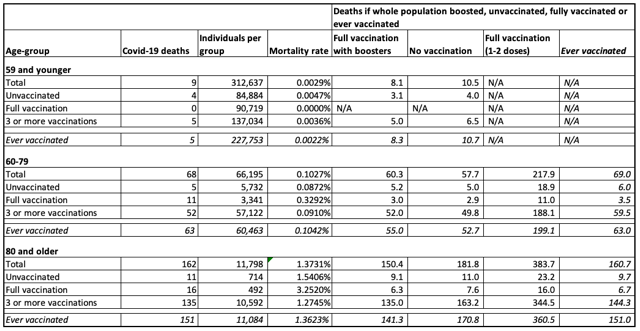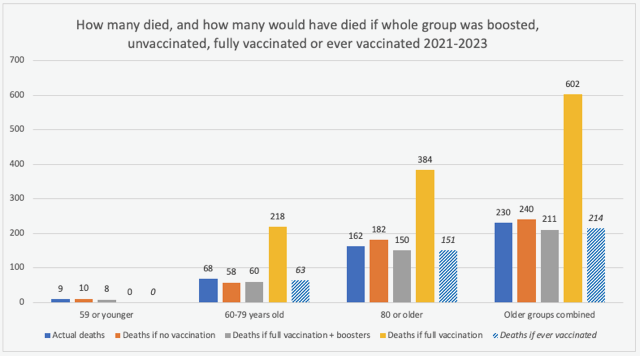Now that the numbers are in, the Icelandic Chief Medical Officer (CMO) claims vaccination against Covid-19 reduced the probability of death from the disease by half, compared with no vaccination. But the actual figures tell a very different story, and the method used to arrive at this conclusion is questionable to say the least. The actual reduction in deaths is negligible at best, and the most worrying result is how those fully vaccinated (two doses) were almost three times more likely to die from the disease than the unvaccinated.
In summary, only 20 lives were potentially saved in Iceland by Covid-19 vaccination, while 60-70 may have been lost to the disease in the vaccinated. When we take into account the number of deaths reported following vaccination, the overall result of the experiment is likely to be negative.
In September, the office of Iceland’s Chief Medical Officer published a news release on the results from a study of the effectiveness of the Covid-19 vaccines. They claim that those fully vaccinated and boosted were only half as likely to die from Covid-19, compared with those unvaccinated, using 2022 numbers. As demonstrated below, this claim is false.
I have compared the data on Covid-19 deaths by age and vaccination status, received from the Chief Medical Officer, with the already published and available data on vaccination status by age group. As the population data by year, age group and vaccination status obtained from the CMO is unusable, as I explain in more detail later, I use the total number vaccinated over the whole period instead, so my analysis applies to the whole period, rather than 2022 only. But considering how 94 percent of the deaths occurred in 2022 anyway, it is very unlikely that a more detailed breakdown would affect the results in any meaningful way.
Table 1: Covid-19 deaths and the effect of vaccination, 2021-2023

Sources: Andlát Covid-19 og bólusetningarstaða 2020 2023.pdf, received by email on October 6th 2023, accessible at https://www.prim.is/c19-death_by_injections.pdf, https://www.covid.is/statistical-information-on-vaccination, https://www.covid.is/data
So, here’s what I’ve done. I calculate the crude mortality rate by dividing the number of deaths by the number of individuals, split by vaccination status and age group. Note that this is not IFR or CFR, just deaths as a percentage of group population. I then use the mortality rate of the boosted group to calculate the expected number of deaths among the unvaccinated and fully vaccinated (2 doses), had they been vaccinated and boosted. This way I can estimate the number of lives saved or lost due to the boosters among those two groups.
I then do the same to find the resulting number of lives saved or lost, had the fully vaccinated and the boosted not been vaccinated at all, using the mortality rate of the unvaccinated.
Finally, I apply the mortality rate of the fully vaccinated (2 doses) to the boosted and the unvaccinated to calculate the mortality, had those groups been vaccinated with 2 doses.
The results indicate how, in the youngest group, about 10 percent fewer would have died had the whole group been vaccinated and boosted, compared with the actuals. This result is not statistically valid however, due to the extremely low number of total deaths in this age group.
For those aged 60-79, full vaccination with boosters would have resulted in 11 percent fewer deaths, and for those 80 and older, 7 percent fewer, compared with the actuals. Interestingly, for the 60-79 age group, the boosters would have yielded 4 percent more deaths than no vaccination at all.
On the whole, for 2021-2023, full vaccination with boosters among the two older groups, where we have statistically significant data, would have resulted in 8.4 percent fewer deaths only, compared with the actuals, just under 20 lives saved in total, and 12 percent fewer than if no one had been vaccinated. A far cry from the 50 percent reduction in mortality risk claimed by the Chief Medical Officer.
What is particularly interesting here is the high mortality rate among those who received 1-2 doses of the vaccine (96 percent of those had 2 doses, so-called ‘full vaccination’). There were no deaths in this category among the youngest group (the same caution applies as before, due to lack of statistical significance), but for both the older age groups, had everyone received 2 doses of the vaccine instead of either none, or 3 or more, the death toll from Covid-19 would have almost tripled.

See Table 1 for references.
Shocking indeed. But when we consider the indications we already have of how the probability of infection increases with time after vaccination, doubles with every dose after a certain period of time, it sadly does not come as a big surprise. What the long-term development will be is uncertain.
Will this risk keep increasing with time? Are those who have received the vaccine doomed to enter a constant cycle of boosters against a relatively harmless disease for the foreseeable future, to avoid the elevated mortality risk should they catch the virus? And considering how each dose increases the probability of infection, what is then the downside of the continued vaccine boosters? Those questions should be a top priority in medical research, but of course they aren’t.
The Icelandic Medicines Agency has now received more than 6,000 reports of adverse effects following Covid-19 vaccination. Of these, 360 are classified as serious, according to a recent press release. This amounts to around one in every 800 people vaccinated. Compared with adverse effects from influenza vaccination, this is between 500 and 1,000-fold the rate one might have expected. We already saw indications of this a long time ago, and we’ve seen confirmations of this ratio from other countries, again and again. This is yet another one.
Still, we do not have directly established causal links, as it seems the cases are only registered, but for some reason the causality never gets investigated and is therefore never directly established.
The latest detailed report appeared well over a year ago, in April 2022. At that time, the agency had received around 3,600 reports of adverse effects. Of those, 293 were classified as serious, and there were 36 reported deaths. If we extrapolate directly, it may be assumed that we may now have a total of between 60 and 70 deaths, around a quarter of the total reported deaths from Covid-19.
Based on the numbers and the research quoted, it seems reasonable to expect that the vaccination will eventually result in an increase, rather than a decrease in Covid-19 deaths. And if we take into account the estimated 60-670 deaths following vaccination — approximately triple the currently estimated number of lives saved by dose 3, 4 and 5 — the vaccination has probably already led to an increase in the total number of lives lost, compared with no vaccination. And then we haven’t even begun to consider the hundreds of serious adverse effects reported.
The question remains how the CMO managed to conclude that the mortality among the boosted was 50 percent lower in 2022 than among the unvaccinated. On what basis do they make this claim?
After extensive email exchanges with the Chief Epidemiologist in the Chief Medical Officer’s office, the explanation is now clear. In the table on which their mortality calculations are based, the unvaccinated and fully vaccinated (1-2 doses) are lumped together as ‘unvaccinated,’ while only those both fully vaccinated and boosted are counted as ‘vaccinated’ (this is why I couldn’t use those data for reference; they don’t properly distinguish between the groups).
As discussed above, mortality among the fully vaccinated but without boosters is almost three times that of the other two groups. Lumping them together with those actually unvaccinated, then slapping the ‘unvaccinated’ stamp on the whole group, explains the high mortality rate among those classified as unvaccinated in the two older age groups. Then, having conveniently redefined the meaning of the word ‘unvaccinated’ to include the fully vaccinated also, the CMO sent out their press release on September 13, claiming a 50 percent reduction in mortality among the ‘fully vaccinated’ (in fact yet another redefinition).

Table 2: Excerpt from the Chief Medical Officer’s datasheet. See Table 1 for reference.
As explained above, judging by the actual – not fabricated – breakdown by vaccination status, it is clear that the Chief Medical Officer’s claim that full vaccination with boosters reduced the probability of death from Covid-19 by half, compared with no vaccination, is totally unwarranted. At best, weighed against the promises made at the time, the positive effect of the vaccination is negligible as things stand now, and most probably negative when we count in deaths following vaccination. And it is particularly worrying that the Chief Medical Officer continues to push for yet more boosters for the 60-79 age group, where the net benefit of the boosters is in fact negative, compared with no vaccination.
As I was exploring this, it came to my attention that the Icelandic Ministry for Healthcare recently proposed amendments to the patient insurance legislation, lowering the requirements for insurance payout due to vaccination ‘recommended by the health authorities,’ and raising the maximum amount of compensation. This indicates how the authorities are now beginning to brace for the consequences of the biggest and most devastating medical experiment in history, while at the same time continuing knowingly to aggravate the problem.
In 2021, health authorities and prominent health professionals kept repeating claims of the miraculous effectiveness of the Covid-19 vaccines. How they were saving hundreds of lives. How the unvaccinated were filling up hospital beds. Some even called for the unvaccinated to be permanently excluded from society and put in lifelong quarantine.
Looking at the numbers now, it is utterly clear that those claims were simply untrue. But they were repeated again and again by the media, without a shred of criticism, no questions asked, no doubts raised, no evidence ever required. As we see, looking at the latest press release, the authorities continue to spread those false claims, in fact now going to unprecedented lengths to justify them. And as long as the vast majority of the population chooses to believe them, and as the barriers protecting government misinformation keep rising, will they ever cease?
Republished from The Conservative Woman
Join the conversation:

Published under a Creative Commons Attribution 4.0 International License
For reprints, please set the canonical link back to the original Brownstone Institute Article and Author.









